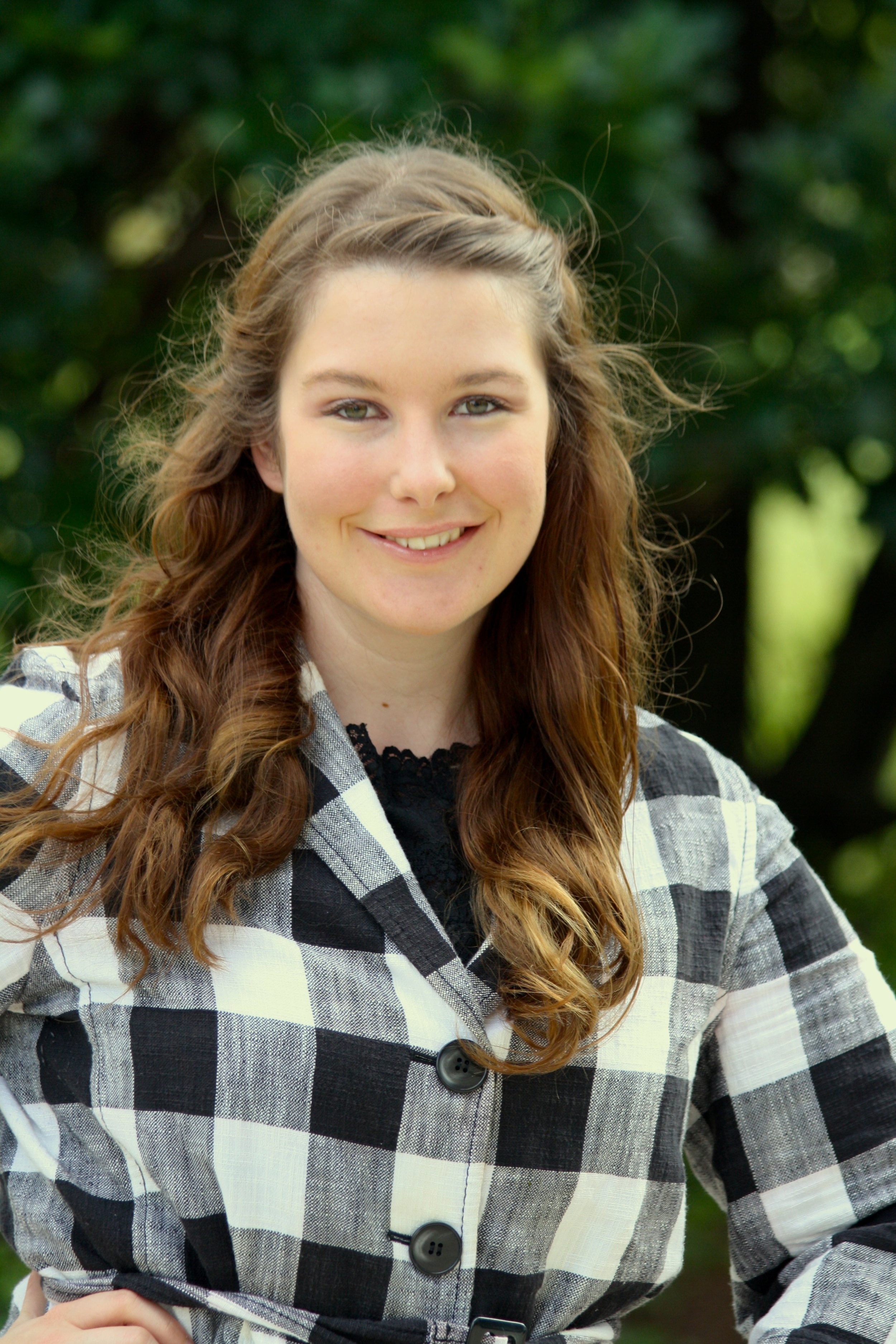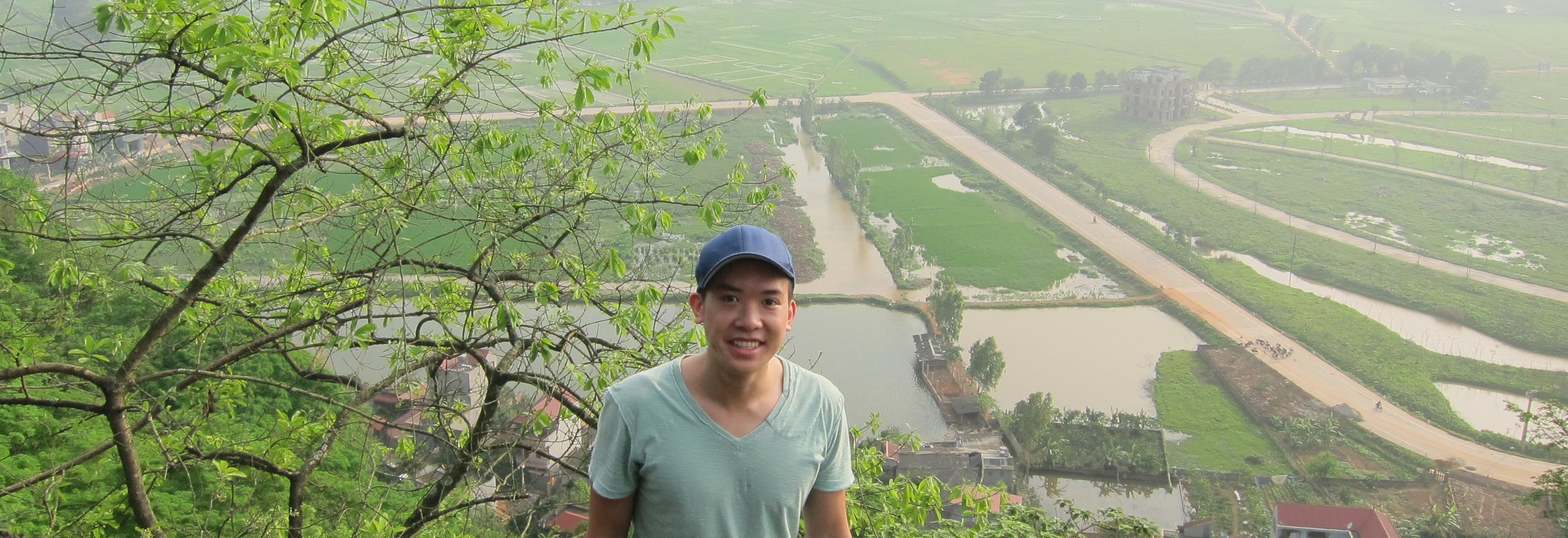Congratulations to PhD Candidate Kaitlin Patterson for winning one of the CIHR's Michael Smith Foreign Study Supplements! With this award, Kate will be hosted and supervised by Dr. Shuaib Lwasa at Makerere University in Uganda, and supported by the Batwa Development Program, the Bwindi Community Hospital, and the Ugandan Ministry of Health to continue her research, working with Indigenous Batwa to characterize maternal health. During her award tenure, she will: 1) continue her investigation to identify maternal health opportunities in Kanungu district, including the mobilization and dissemination of these findings, 2) collaborate with Indigenous partners to co-produce and co-write two journal articles, and 3) formalize an international health research network between Canadian and Ugandan students. Congratulations Kate!
Vivienne Steele selected to serve as a Young Leader for Women Deliver
Congratulations to Vivienne Steele (MSc Candidate) for being selected as a Young Leader in the Women Deliver program! "The award-winning Women Deliver Young Leaders Program provides youth advocates with opportunities to take their work advancing gender equality to the next level." The Young Leaders are selected "for their potential to have a lasting impact on the lives of girls and women. As a group, they have already driven tangible progress on a wide range of issues, including sexual and reproductive health and rights, LGBTQ+ rights, peace and security, water and sanitation, gender-based violence, education, maternal health, and political participation."
"This was the program’s most competitive application process yet, with nearly 3,000 applications for 300 spots. It is also the largest and most diverse cohort to join the award-winning program: the group hails from 121 countries and collectively speaks 98 languages. The Young Leaders also include people from communities too often marginalized, including 66 people affected by humanitarian emergencies, 29 self-identified indigenous persons, and — for the first time — 18 adolescents."
Congratulations Vivienne!
Reflecting on the Arctic Change Conference
Written by Jacqueline Middleton, PhD Candidate This year’s annual ArcticNet meeting (Arctic Change 2017) was held in the historical Quebec City, QC, from December 11-15, 2017. The international conference hosted Arctic researchers, stakeholders, and community representatives from across the North. Over 60 topical sessions and more than 350 posters across disciplines encouraged learning and discussion among attendees. The venue also promoted relationship building as it conveniently provided space for side meetings necessary for project partners to collaborate.
Once again, a fantastic Student Day was held with a focus on ‘International Cooperation and Collaboration in Arctic Research’, and had its inaugural ‘Elevator Pitch’ competition, where students from across disciplines were challenged to engage audiences with a one-minute oral presentation on their poster. The Harper Lab’s own Anna Manore participated in this competition – presenting on her Master’s work with the PAWS project on shellfish contaminants in Iqaluit.
The Harper Lab contributed a number of oral and poster presentations, showcasing our research group’s work on environmental health surveillance and monitoring, mental wellbeing, as well as water and food security.
After an engaging week learning about the forefront of Arctic research, the conference ended with a beautiful banquet where awards and acknowledgements were presented, including PhD candidate Alex Sawatzky who won first place in the Health and Social Sciences category in the graduate student poster competition! The evening closed with a fantastic performance by Iqaluit artists The Jerry Cans. It was a privilege and a tremendous pleasure to participate and attend Arctic Change 2017. The Harper Lab can’t wait for next year!
The Lab "Plays with Clay": Team Building
Written by Vivienne Steele and Carlee WrightOn December 5th, our lab went to Play with Clay to make hand-crafted mugs! With guidance from staff we learned to roll and cut shapes from fresh clay, and everyone decorated their mugs with fun stamps, lace, and stencils. After painting and glazing, they were fired in the kiln and ready for use! This event was rewarding and relaxing after everyone's busy semesters - a chance to create unique pottery pieces in wonderful company.
How are perceptions associated with water consumption in Canadian Inuit? Check Out this New Publication to Find Out!
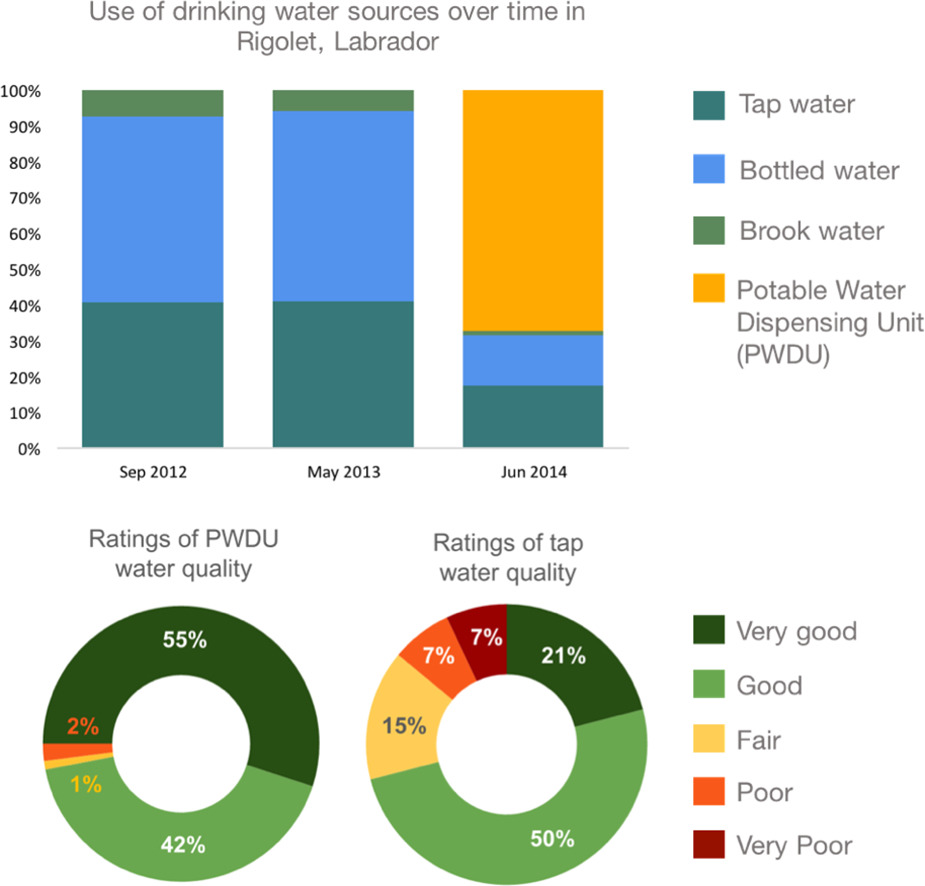 Congratulations to Carlee Wright for publishing her second article from her MSc thesis! Click here to read the full article...
Citation: Wright, C.J., Sargeant, J.M., Edge, V.L., Ford, J.D., Farahbakhsh, K., Shiwak, I., Flowers, C., Gordon, A.C., RICG, IHACC Research Team (Berrang-Ford, L., Carcamo, C., Llanos, A., Lwasa, S., Namanya, D.B.), and Harper, S.L. (2018). How are perceptions associated with water consumption in Canadian Inuit? A cross-sectional survey in Rigolet, Labrador. Science of The Total Environment, 618(15): 369–378.
Congratulations to Carlee Wright for publishing her second article from her MSc thesis! Click here to read the full article...
Citation: Wright, C.J., Sargeant, J.M., Edge, V.L., Ford, J.D., Farahbakhsh, K., Shiwak, I., Flowers, C., Gordon, A.C., RICG, IHACC Research Team (Berrang-Ford, L., Carcamo, C., Llanos, A., Lwasa, S., Namanya, D.B.), and Harper, S.L. (2018). How are perceptions associated with water consumption in Canadian Inuit? A cross-sectional survey in Rigolet, Labrador. Science of The Total Environment, 618(15): 369–378.
Abstract
Concerns regarding the safety and aesthetic qualities of one's municipal drinking water supply are important factors influencing drinking water perceptions and consumption patterns (i.e. sources used and daily volume of consumption). In northern Canada, Inuit communities face challenges with drinking water quality, and many Inuit have reported concerns regarding the safety of their drinking water. The objectives of this research were to describe perceptions of municipal tap water, examine use of water sources and changes following the installation of a potable water dispensing unit (PWDU) in 2014, and identify factors associated with water consumption in the Inuit community of Rigolet. This study used data from three cross-sectional census surveys conducted between 2012 and 2014. Principal component analysis (PCA) was used to aggregate data from multiple variables related to perceptions of water, and logistic regressions were used to identify variables associated with water consumption patterns. Three quarters of residents reported using the PWDU after its installation, with concomitant declines reported in consumption of bottled, tap, and brook water. Negative perceptions of tap water were associated with lower odds of consuming tap water (ORPCAcomponent1 = 0.73, 95% CI 0.56–0.94; ORPCAcomponent2 = 0.67, 95% CI 0.49–0.93); women had higher odds of drinking purchased water compared to men (OR = 1.90, 95% CI 1.11–3.26). The median amount of water consumed per day was 1 L. Using brook water (OR = 2.60, 95% CI 1.22–5.56) and living in a household where no one had full-time employment (OR = 2.94, 95% CI 1.35–6.39) were associated with consuming > 2 L of water per day. Results of this study may inform drinking water interventions, risk assessments, and public health messaging in Rigolet and other Indigenous communities.
Participatory Scenario Planning for Climate Change - New Publication!
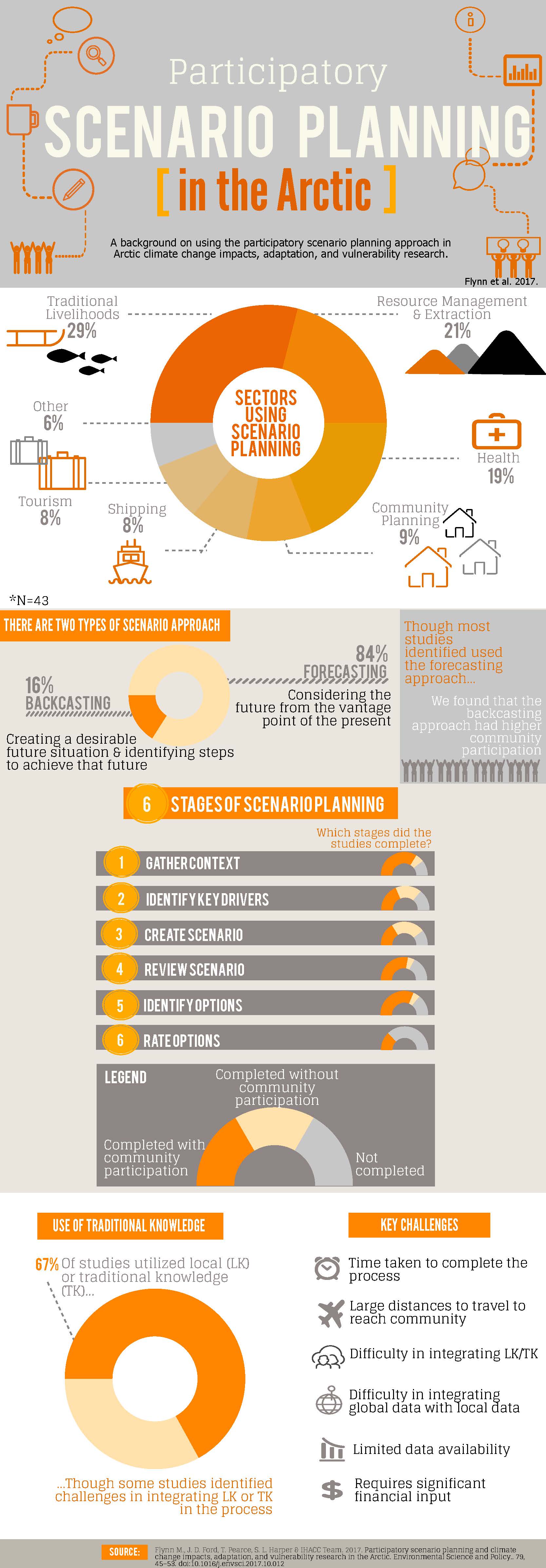 Congratulations to Melanie Flynn, for her recent publication in Environmental Science & Policy! Melanie conducted a systematic review of the literature to identify and evaluate how participatory scenario planning has been used in the Arctic.
Congratulations to Melanie Flynn, for her recent publication in Environmental Science & Policy! Melanie conducted a systematic review of the literature to identify and evaluate how participatory scenario planning has been used in the Arctic.
Citation:
Flynn, M., Ford, J., Pearce, T., and Harper, S.L. (2018). Participatory scenario planning and climate change impacts, adaptation and vulnerability research in the Arctic. Environmental Science & Policy. 79:45–53.
Abstract:
Participatory scenario planning (PSP) approaches are increasingly being used in research on climate change impacts, adaptation, and vulnerability (IAV). We identify and evaluate how PSP has been used in IAV studies in the Arctic, reviewing work published in the peer-reviewed and grey literature (n = 43). Studies utilizing PSP commonly follow the stages recognized as ‘best practice’ in the general literature in scenario planning, engaging with multiple ways of knowing including western science and traditional knowledge, and are employed in a diversity of sectors. Community participation, however, varies between studies, and climate projections are only utilized in just over half of the studies reviewed, raising concern that important future drivers of change are not fully captured. The time required to conduct PSP, involving extensive community engagement, was consistently reported as a challenge, and for application in Indigenous communities requires careful consideration of local culture, values, and belief systems on what it means to prepare for future climate impacts.
Community-based Research Update: Nia & Kate in Uganda
Written by Nia King, Research Associate About two weeks ago I arrived in Uganda to work as a research assistant alongside Kate Patterson (PhD candidate), investigating rural maternal health and working to develop a knowledge translation strategy for IHACC Uganda. We are staying at the Monkey House, and have been joined by a wide variety of interesting visitors, including a group of external hospital auditors, tropical health students from the London School of Tropical Health and Medicine, two Americans who have spent the past two years driving in a camper van across Africa, and Dr. Kellerman, founder of Bwindi Community Hospital. This has made for a very lively and fun living environment!
With the quantitative maternal health surveys having been completed this past summer, we are now working with local research associates Seba, Charity, and Grace to conduct qualitative focus group discussions and individual interviews with mothers and fathers in Batwa and Bakiga communities throughout the Kanungu District. As the primary focus of Kate’s research is Indigenous maternal health, we are conducting repeated weekly focus group discussions with women in three Batwa settlements, chosen to capture the variety in geographies and access to healthcare. By spending approximately six hours discussing with each group of women, we are starting to capture and understand many of the nuances related to maternal health in rural Uganda. In addition to these focus groups, we have conducted focus group discussions with Batwa men and Bakiga (non-Indigenous) women. Kate has also been working with 9 Batwa women conducting repeated individual interviews to gather personal narratives surrounding maternal health. Through these various engagements, we have met many amazing women throughout the past couple weeks and look forward to providing them with a platform to voice their challenges and concerns. Our findings are intended to inform maternal health programs and delivery at the Bwindi Community Hospital and surrounding healthcare facilities.
When not in the communities, we have had the opportunity to partake in several hikes, including one that leads to a ridge overlooking the Ugandan and Democratic Republic of Congo border. Kate was also amazing and arranged a birthday party (including a homemade banana-nutella cake) for me last week, which made spending my birthday away from home extra special.
Overall our work is progressing smoothly here. I am so lucky to have the opportunity to live in this amazing part of the world and to learn from all of Kate’s experience. I look forward to the next two weeks—the time here is flying and pretty soon I’ll be hopping on a plane back home!
Congratulations to Lindsay Day
Congratulations to Steven Lam!
Congratulations to Lindsay Day!
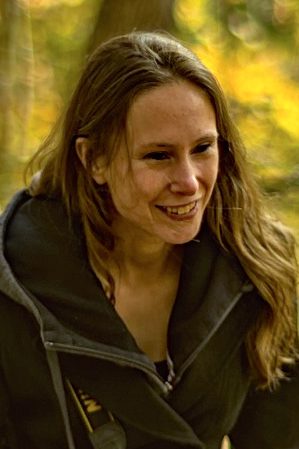 Sincerest congratulations to Lindsay Day, as she begins her new job at the Gordon Foundation, as a Program Coordinator for the MacKenzie DataStream. The Gordon Foundation is "a charitable organization dedicated to protecting Canada's water and empowering Canada's North. [They] seek opportunities to amplify underrepresented voices, elevate emerging issues, and collaborate with like-minded organizations to drive powerful, sustainable outcomes."
Lindsay completed a MSc in the Department of Population Medicine. Her thesis and Water Dialogues podcast examined reconciling our relationships with water, through the development and use of a collaborative podcasting methodology to explore and share diverse First Nations, Inuit, and Métis Perspectives.
Sincerest congratulations to Lindsay Day, as she begins her new job at the Gordon Foundation, as a Program Coordinator for the MacKenzie DataStream. The Gordon Foundation is "a charitable organization dedicated to protecting Canada's water and empowering Canada's North. [They] seek opportunities to amplify underrepresented voices, elevate emerging issues, and collaborate with like-minded organizations to drive powerful, sustainable outcomes."
Lindsay completed a MSc in the Department of Population Medicine. Her thesis and Water Dialogues podcast examined reconciling our relationships with water, through the development and use of a collaborative podcasting methodology to explore and share diverse First Nations, Inuit, and Métis Perspectives.
Congratulations Lindsay!
Photos of Lindsay's Research
Canadian and Australian perspectives on promising practices for integrative Indigenous and Western knowledge systems
Congratulations to first-author Rob Stefanelli, from Heather Castleden's HEC Lab, on his publication that examines Canadian and Australian researchers' perspectives on promising practices for implementing indigenous and Western knowledge systems in water research and management.
Citation:
Stefanelli, R., Castleden, H., Cunsolo, A., Martin, D., Harper, S.L. and Hart, C., 2017. Canadian and Australian researchers' perspectives on promising practices for implementing indigenous and Western knowledge systems in water research and management. Water Policy, DOI: 10.2166/wp.2017.181. Click here to access the article.
Abstract:
National and international policies have called for the inclusion of Indigenous peoples and the uptake of Indigenous knowledge alongside Western knowledge in natural resource management. Such policy decisions have led to a recent proliferation of research projects seeking to apply both Indigenous and Western knowledge in water research and management. While these policies require people with knowledge from both Western and Indigenous perspectives to collaborate and share knowledge, how best to create and foster these partnerships is less understood. To elicit this understanding, 17 semi-structured interviews were completed with academic researchers from Canada and Australia who conduct integrative water research. Participants, most of whom were non-Indigenous, were asked to expand on their experiences in conducting integrative water research projects, and findings were thematically analyzed. Our findings suggest that Indigenous and Western knowledge systems influence how one relates to water, and that partnerships require a recognition and acceptance of these differences. We learned that community-based participatory research approaches, and the associated tenets of fostering mutual trust and community ownership for such an approach, are integral to the meaningful engagement that is essential for developing collaborative partnerships to implement both Indigenous and Western knowledge systems and better care for water.
New Publication! Water quality and health in northern Canada
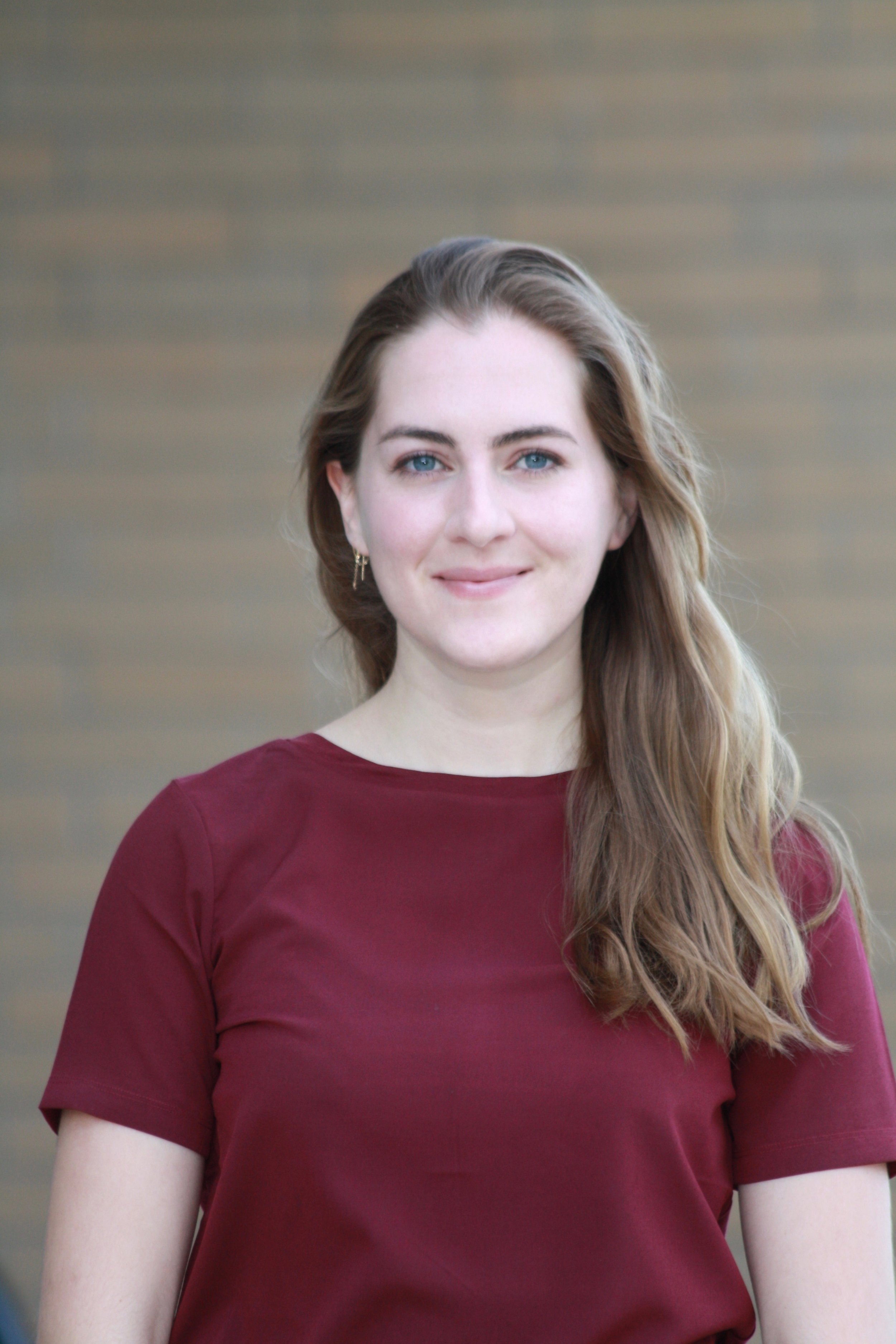 Congratulations to Carlee Wright on her first first-author publication! Carlee worked with the Rigolet Inuit Community Government to examine potential associations between stored drinking water and acute gastrointestinal illness in Labrador Inuit.
Citation: Wright, C.J., Sargeant, J.M., Edge, V.L., Ford, J.D., Farahbakhsh, K., Shiwak, I., Flowers, C., IHACC Research Team, and Harper, S.L. (2017). Water quality and health in northern Canada: stored drinking water and acute gastrointestinal illness in Labrador Inuit. Environmental Science and Pollution Research, DOI: 10.1007/s11356-017-9695-9. Click here to access the article.
Congratulations to Carlee Wright on her first first-author publication! Carlee worked with the Rigolet Inuit Community Government to examine potential associations between stored drinking water and acute gastrointestinal illness in Labrador Inuit.
Citation: Wright, C.J., Sargeant, J.M., Edge, V.L., Ford, J.D., Farahbakhsh, K., Shiwak, I., Flowers, C., IHACC Research Team, and Harper, S.L. (2017). Water quality and health in northern Canada: stored drinking water and acute gastrointestinal illness in Labrador Inuit. Environmental Science and Pollution Research, DOI: 10.1007/s11356-017-9695-9. Click here to access the article.
Abstract: One of the highest self-reported incidence rates of acute gastrointestinal illness (AGI) in the global peer-reviewed literature occurs in Inuit communities in the Canadian Arctic. This high incidence of illness could be due, in part, to the consumption of contaminated water, as many northern communities face challenges related to the quality of municipal drinking water. Furthermore, many Inuit store drinking water in containers in the home, which could increase the risk of contamination between source and point-of-use (i.e., water recontamination during storage). To examine this risk, this research characterized drinking water collection and storage practices, identified potential risk factors for water contamination between source and point-of-use, and examined possible associations between drinking water contamination and self-reported AGI in the Inuit community of Rigolet, Canada. The study included a cross-sectional census survey that captured data on types of drinking water used, household practices related to drinking water (e.g., how it was collected and stored), physical characteristics of water storage containers, and self-reported AGI. Additionally, water samples were collected from all identified drinking water containers in homes and analyzed for presence of Escherichia coli and total coliforms. Despite municipally treated tap water being available in all homes, 77.6% of households had alternative sources of drinking water stored in containers, and of these containers, 25.2% tested positive for total coliforms. The use of transfer devices and water dippers (i.e., smaller bowls or measuring cups) for the collection and retrieval of water from containers were both significantly associated with increased odds of total coliform presence in stored water (ORtransfer device = 3.4, 95% CI 1.2–11.7; ORdipper = 13.4, 95% CI 3.8–47.1). Twenty-eight-day period prevalence of self-reported AGI during the month before the survey was 17.2% (95% CI 13.0–22.5), which yielded an annual incidence rate of 2.4 cases per person per year (95% CI 1.8–3.1); no water-related risk factors were significantly associated with AGI. Considering the high prevalence of, and risk factors associated with, indicator bacteria in drinking water stored in containers, potential exposure to waterborne pathogens may be minimized through interventions at the household level.
Photos of Carlee's Research
Indigenous Maternal Health Research in Uganda
Written by Julia Bryson, Undergraduate Researcher PhD Candidate Kate Patterson and Research Assistants Julia Bryson, Mackenzie Wilson, and Emma Windfeld, along with two core IHACC students Grace Asaasira and Phiny Smith of Makerere University, have been working in Uganda researching maternal health among Indigenous and non-Indigenous communities in Kanungu District. Here is an update on their work and adventures!
It is hard for us to believe, but we have officially completed our work in the communities of Kanungu District and are back in Kampala! It seems like it was just yesterday that we arrived in beautiful Buhoma. We will miss its rolling green hills, and even the mischievous monkeys that frequented the appropriately-named Monkey House we called home.
The past few weeks have been busy as we approached the end of our time in Buhoma—finishing data collection, sharing preliminary findings with our local partners, and saying many, many goodbyes to all the amazing people we have worked and lived with for the past six weeks. In total, we visited twenty communities over five weeks and surveyed approximately 600 women about their maternal health histories. Mackenzie and Julia also conducted sixteen focus group interviews to learn more about maternal nutrition and antenatal care in the area, and Emma spoke with several groups of community members about climate and food security associations.
The weekend before our departure, we took the opportunity to celebrate our amazing team of local surveyors, including students from our partner Makerere University, with some delicious local food and dancing. None of our work would have been possible without their time, effort, and enthusiasm!
We were also excited to have the opportunity to share about our research with one of our key partners in Buhoma, Bwindi Community Hospital (BCH). We presented our research methods and preliminary findings with over thirty BCH health care workers and administrators and had fruitful discussions about future steps as we work together to use the information we have gathered to improve health in the area. The knowledge and expertise of our BCH partners is integral to the success of our work, and we are so grateful to be able to collaborate with them and continue to build these important relationships throughout the project.
The drive back to Kampala was lengthy, but full of adventure! We drove through the gorgeous Queen Elizabeth National Park and were lucky enough to spot one of the elusive tree-climbing lions, thanks to the sharp eye of our driver, Maddy. We also saw antelopes, baboons, monkeys, buffalo, and even elephants! An unexpected safari on the way to the city was a great way to cap off our time in the south of Uganda. We look forward to exploring the city of Kampala and meeting with our key partners at Makerere University over the next two weeks as we wrap up this stage of the project and look ahead to the future. There’s never a dull moment!
Congratulations to Jamie Snook for winning a Trudeau Doctoral Scholarship!
 Sincerest congratulations to PhD student, Jamie Snook, on this prestigious and well-deserved honour!
Sincerest congratulations to PhD student, Jamie Snook, on this prestigious and well-deserved honour!
Anna Reports from Russia: The Collaborative Arctic Summer School in Epidemiology
Written by Anna Manore, MSc Candidate
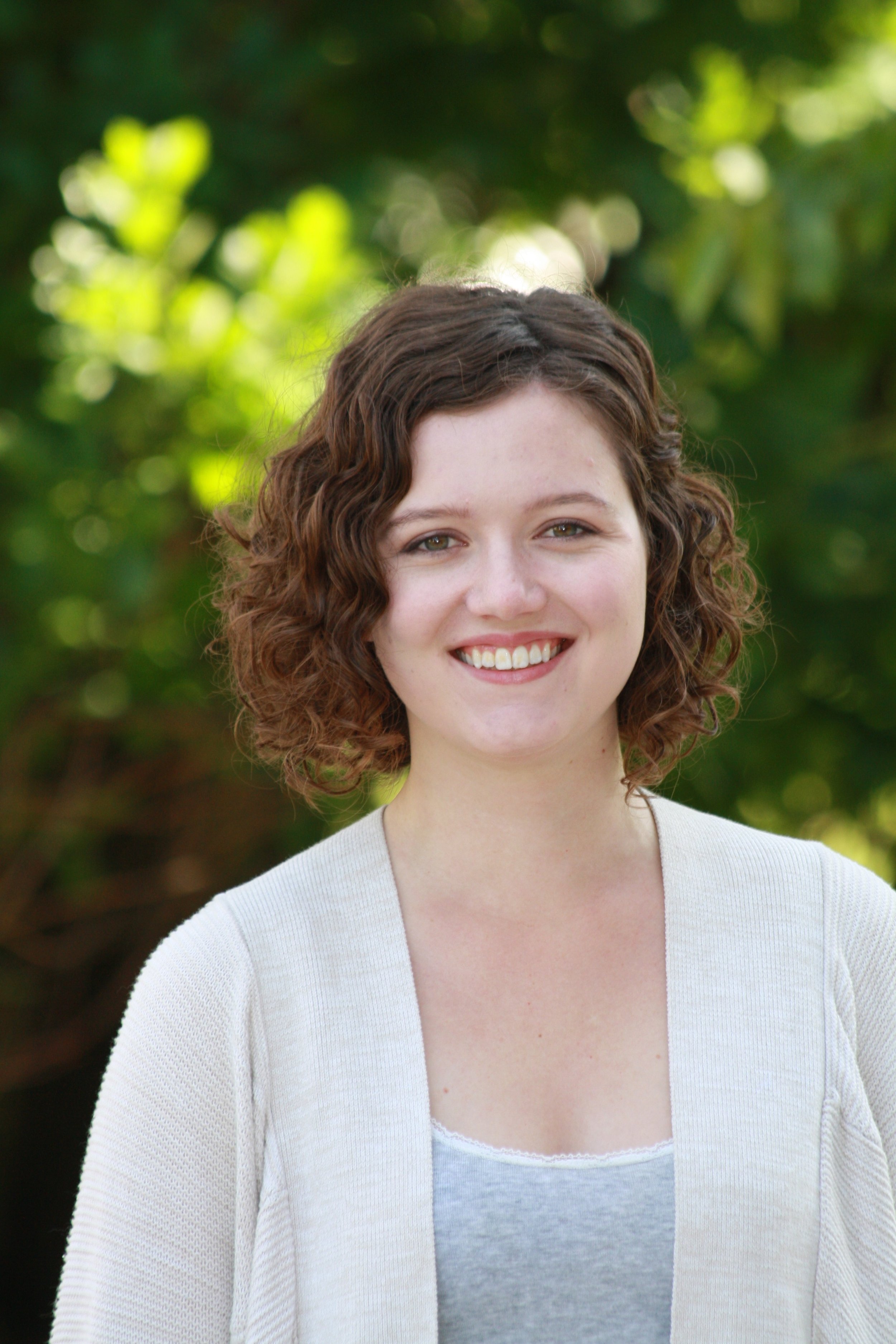 After many long flights, I landed in Arkhangelsk, Russia, to begin a week of learning with the Collaborative Arctic Summer School in Epidemiology (CASE). CASE is a meeting of epidemiology faculty and students from the United States, Canada, Norway, and Russia. It’s a great opportunity to meet with other researchers working in Arctic contexts, and I’m fortunate because this was my second time attending! A few other CASE participants from Alaska had been on my flight from Moscow, and after waiting for the rest of the participants’ flights to arrive, we set off on a 3.5-hour drive to Golubino.
After many long flights, I landed in Arkhangelsk, Russia, to begin a week of learning with the Collaborative Arctic Summer School in Epidemiology (CASE). CASE is a meeting of epidemiology faculty and students from the United States, Canada, Norway, and Russia. It’s a great opportunity to meet with other researchers working in Arctic contexts, and I’m fortunate because this was my second time attending! A few other CASE participants from Alaska had been on my flight from Moscow, and after waiting for the rest of the participants’ flights to arrive, we set off on a 3.5-hour drive to Golubino.
Golubino is a resort along the Pinega River, and it was the beautiful setting of CASE 2017. The food was delicious, and always surprising! Breakfast on the first day included porridge with berries (surprisingly savoury), and small pastries (surprisingly filled with fish). Presentations from faculty and students began almost immediately, and continued throughout the week. Although every presentation focused on Arctic Epidemiology, the populations and outcomes of interest varied widely. We heard about suicide and suicide prevention, cardiovascular disease, perinatal outcomes, and environmental contaminants, among other topics. One presentation that stood out was by Ketil Lenert Hansen from the University of Tromsø- on the topic of “Ethical and methodological Issues in working with Indigenous peoples in the Arctic”, and focused on the Sámi context in Northern Europe. From Ketil’s talk, there seemed to be common themes between issues faced by Sámi and by Indigenous peoples in Canada. Ketil also recommended a film, “Sámi Blood”, which is a dramatized telling of a Sámi girl’s experience growing up in Sweden in the 1930s.
In the evenings, we had time for activities! The first night’s adventure was a walk through the Taiga forest to a holy spring. Some in our group were suffering from stuffy noses, so our tour guide showed us how to use the forest ants as a remedy. There were large anthills made of pine needles along our path, and to help a stuffy nose, you tap your hands three times on the anthill, bring your hands to your face, and inhale. The ants make your hands smell like vinegar, which, we all learned, is very effective at clearing out sinuses.
Tuesday night’s activity was an excursion to the nearby “Golubinsky proval” karst caves. These are limestone caves carved by water, and there are tunnels are over a kilometre long. The temperature inside the caves is much cooler than outside, so the white limestone was coated in ice. Unfortunately, most of the tunnels were flooded, so we couldn’t go very far into the cave. But – what we could see was stunning, and definitely worth getting all dressed up for!
Wednesday night was team-building activities, followed by a campfire, tea tasting, and traditional songs and dances by the river. We heard that the singers, dressed in traditional costume, are all local retirees! Our last night, Thursday, saw us all making “Pinega shanezhki” pies and relaxing after a trip to a monastery. Friday was our long drive back to Arkhangelsk, with a stop at “Malye Korely”, an open-air museum of wooden architecture from the Arkhangelsk Region. From the museum, it was back to Arkhangelsk and the airport – a great end to a great week at CASE!
Indigenous Maternal Health Research in Uganda
Written by Emma Windfeld, Research Assistant Kate Patterson, a PhD student at the University of Guelph, is completing her thesis on maternal health among Indigenous and non-Indigenous populations. Kate and three research assistants—Julia Bryson, Mackenzie Wilson, and Emma Windfeld—are conducting fieldwork in Buhoma, where they will spend a total of five weeks. When they arrived in Buhoma two weeks ago they were welcomed into the "Monkey House," which they are very happy to call home for their time here. The Monkey House is a quiet and welcoming accommodation built on a hill above Bwindi Community Hospital. It is named after the mischievous red-tailed monkeys that scamper around the roof and swing through the trees that surround the house, and that occasionally cause a stir by fighting with the chickens that roam the backyard. Kate, Julia, Mackenzie, and Emma often enjoy working on the back porch but have to be careful that the monkeys don’t snatch their pens or phones.
For the past two weeks here in Buhoma, the four researchers have traveled by car or on foot to nearby communities in Uganda’s Kanungu District to gather maternal health data through surveys of the local women. Half of each week is spent in Batwa settlements and half is spent in Bakiga settlements. The Batwa are an Indigenous people who lived as hunter-gatherers in the nearby Bwindi Impenetrable National Forest until they were evicted by the government two decades ago. The Bakiga are the local inhabitants of the Kanungu district. Two core Ugandan Indigenous Health Adaptation to Climate Change (IHACC) team members from Makerere University, Grace Asaasira and Phiny Smith, have been instrumental partners. In addition to helping with the community surveys, Grace and Phiny have helped the Canadian researchers get to know the local area and shared a lot of interesting conversations about cultural similarities and differences. Overall, the fieldwork has been progressing successfully so far and everyone is looking forward to the next three weeks of working with the communities.
At the Monkey House, Kate, Julia, Mackenzie, and Emma have enjoyed sharing yummy meals, stimulating conversations, and fun movie nights with the doctors and nurses who work or volunteer at Bwindi Community Hospital. On their days off, the four researchers have gone gorilla trekking and hiking in Bwindi Impenetrable National Forest with its rolling mountains and lush vegetation. They have also enjoyed a day at one of the many local coffee plantations, where they got to learn about coffee making from picking the beans to drinking the freshly roasted brew.
How does seasonality and weather affect perinatal health?
Congratulations to Sarah MacVicar on her recent publication that examines how seasonality and weather affect perinatal Indigenous health in southwestern Uganda! Click here to access the abstract.
Citation: MacVicar, S., Berrang-Ford, L., Harper, S.L., Steele, V., Lwasa, S., Bambaiha, D.N., Twesigomwe, S., Asaasira, G., Ross, N. and IHACC Research Team, 2017. How seasonality and weather affect perinatal health: Comparing the experiences of Indigenous and non-Indigenous mothers in Kanungu District, Uganda. Social Science & Medicine. 187: 39–48.
Abstract: Maternal and newborn health disparities and the health impacts of climate change present grand challenges for global health equity, and there remain knowledge gaps in our understanding of how these challenges intersect. This study examines the pathways through which mothers are affected by seasonal and meteorological factors in sub-Saharan Africa in general, and Kanungu District (Uganda), in particular. We conducted a community-based study consisting of focus group discussions with mothers and interviews with health care workers in Kanungu District. Using a priori and a posterioricoding, we found a diversity of perspectives on the impacts of seasonal and weather exposures, with reporting of more food available in the rainy season. The rainy season was also identified as the period in which women performed physical labour for longer time periods, while work conditions in the dry season were reported to be more difficult due to heat. The causal pathways through which weather and seasonality may be affecting size at birth as reported by Kanungu mothers were consistent with those most frequently reported in the literature elsewhere, including maternal energy balance (nutritional intake and physical exertion output) and seasonal illness. While both Indigenous and non-Indigenous mothers described similar pathways, however, the severity of these experiences differed. Non-Indigenous mothers frequently relied on livestock assets or opportunities for less taxing physical work than Indigenous women, who had fewer options when facing food shortages or transport costs. Findings point to specific entry points for intervention including increased nutritional support in dry season periods of food scarcity, increased diversification of wage labour opportunities, and increased access to contraception. Interventions should be particularly targeted towards Indigenous mothers as they face greater food insecurity, may have fewer sources of income, and face greater overall deprivation than non-Indigenous mothers.
Congratulations to Carlee and Manpreet
On Friday June 16th, 2017, Carlee Wright and Manpreet Saini received their Master of Science at the University of Guelph Convocation. Congratulations!
Nia King wins both top undergraduate convocation awards!
Congratulations to Nia King for winning the top undergraduate convocation awards at the University of Guelph:
- Winegard Medal: "The Winegard Medal is the University of Guelph's top convocation award to an undergraduate student. Named for former University of Guelph president Dr. William Winegard, the medal is awarded in recognition of both academic achievement and contributions to university and community life."
- Governor General Medal: "Lord Dufferin, Canada’s third Governor General after Confederation, created these Academic Medals in 1873 to encourage academic excellence across the nation. Over the years, they have become the most prestigious award that students in Canadian schools can receive."
Citation: Governor General Medal, Read by Sherilee Harper
The University of Guelph awards two silver medals from the Governor General each year to the two graduating students with the highest cumulative average in any undergraduate degree program. Both 2017 recipients are graduates of the College of Biological Science.
Madame Chancellor, I have the honour of presenting to you one of the recipients of the Governor General’s Silver Medal, Nia King.
In her four years at the University, Nia has demonstrated outstanding academic achievement. She is graduating with a B.Sc. Honours degree in Bio-medical Science with a cumulative average of 97.5%. Nia maintained this high level of performance in each semester of her program, earning a grade of at least 97% in 27 of 36 courses, and 100% in five courses.
If those exceptional grades weren’t enough, Nia has been a very productive researcher in the Department of Population Medicine. She has conducted community-based research with Canadian Inuit, Kenyan farmers, and migrant workers in India to advance our understanding of complex public health issues. Nia has presented her work at national conferences, and remarkably is a co-author of four published articles, as well as two currently in review.
Nia has been recognized by the University community on several occasions for her academic achievements. She was awarded the A. Peepre Memorial and Lionel Bradley Pett Scholarships from the Department of Human Health and Nutritional Sciences, and a CBS Student Council Academic Achievement Award based on her sustained academic excellence. These awards were in addition to many other honours, including the College of Biological Science Dean’s scholarship on two occasions and the highly prestigious University of Guelph President’s Scholarship.
In addition to these many academic accomplishments, Nia has also been a very active contributor to the community and an outstanding provincial and national level athlete.
Madame Chancellor, I am sure you will agree that Nia King is an exemplary student and fully deserving of the Governor General’s Silver Medal.
Citation: Winegard Medal, Read by Jonathan Newman
The William Winegard Medal is the University of Guelph’s most prestigious undergraduate student convocation award and is named in honour of Dr. William C. Winegard, a former University of Guelph president. This medal is awarded annually in recognition of both academic achievement and contributions to university and community life.
Madam Vice-Chancellor, I am honoured to present this year’s recipient of the William Winegard Medal, Nia King.
Described as a born leader and a natural scholar, Nia King is a top student in biomedical sciences, a dedicated researcher in public health and an outstanding athlete.
Nia’s academic achievements place her at the top of the 2016/17 graduating class. Further, through a series of research assistantships, she pursued her passion for public health and community engagement by studying Indigenous health and international public health. Nia contributed to the Federal Government’s climate change adaptation strategy for Northern Canada, and advanced our understanding of public health issues in rural India, physical health challenges in the Canadian Arctic, and education in Kenya.
In addition to Nia’s many academic accomplishments, she has been a very active member of the community. She has served as a health care volunteer, a Big Brothers Big Sisters mentor, and coordinator for the TEDxGuelphU series. She was named among Guelph’s Top 40 Under 40, and was chosen as one of three North Americans to serve as an Impossible2Possible Global Youth Ambassador.
Nia also has pursued athletics at the highest level, including running the Boston Marathon, playing ringette for Team Ontario, and rowing for Team Canada. Using her athletics for social good, Nia ran the equivalent of five consecutive marathons across Death Valley for a global education program using adventure learning.
Nia embodies the values of the University of Guelph in her commitment to learning and pursuit of excellence in everything that she does. Her outstanding academic achievements and volunteer work both at the university and abroad, demonstrate that she is a very deserving recipient of this year’s William Winegard Medal.
Food insecurity by season in households with children in Iqaluit
Congratulations to Catherine Huet for her new publication in BMC Public Health! Her article examines food security in household with children in Iqaluit. Click here for free access to the open-access article!
Citation:
Huet, C., Ford, J., Berrang-Ford, L., Edge, V.L., Shirley, J., IHACC Research Team, King, N., Harper, S.L. (2017). Food insecurity and food consumption by season in households with children in an Arctic city: a cross-sectional study. BMC Public Health. 17:578
Abstract:
Background: High rates of food insecurity are documented among Inuit households in Canada; however, data on food insecurity prevalence and seasonality for Inuit households with children are lacking, especially in city centres. This project: (1) compared food consumption patterns for households with and without children, (2) compared the prevalence of food insecurity for households with and without children, (3) compared food consumption patterns and food insecurity prevalence between seasons, and (4) identified factors associated with food insecurity in households with children in Iqaluit, Nunavut, Canada.
Methods: Randomly selected households were surveyed in Iqaluit in September 2012 and May 2013. Household food security status was determined using an adapted United States Department of Agriculture Household Food Security Survey Module. Univariable logistic regressions were used to examine unconditional associations between food security status and demographics, socioeconomics, frequency of food consumption, and method of food preparation in households with children by season.
Results: Households with children (n = 431) and without children (n = 468) participated in the survey. Food insecurity was identified in 32.9% (95% CI: 28.5–37.4%) of households with children; this was significantly higher than in households without children (23.2%, 95% CI: 19.4–27.1%). The prevalence of household food insecurity did not significantly differ by season. Demographic and socioeconomic characteristics of the person responsible for food preparation, including low formal education attainment (ORSept = 4.3, 95% CI: 2.3–8.0; ORMay = 3.2, 95% CI: 1.8–5.8), unemployment (ORSept = 1.1, 95% CI: 1.1–1.3; ORMay = 1.3, 95% CI: 1.1–1.5), and Inuit identity (ORSept = 8.9, 95% CI: 3.4–23.5; ORMay = 21.8, 95% CI: 6.6–72.4), were associated with increased odds of food insecurity in households with children. Fruit and vegetable consumption (ORSept = 0.4, 95% CI: 0.2–0.8; ORMay = 0.5, 95% CI: 0.2–0.9), as well as eating cooked (ORSept = 0.5, 95% CI: 0.3–1.0; ORMay = 0.5, 95% CI: 0.3–0.9) and raw (ORSept = 1.7, 95% CI: 0.9–3.0; ORMay = 1.8, 95% CI: 1.0–3.1) fish were associated with decreased odds of food insecurity among households with children, while eating frozen meat and/or fish (ORSept = 2.6, 95% CI: 1.4–5.0; ORMay = 2.0, 95% CI: 1.1–3.7) was associated with increased odds of food insecurity.
Conclusions: Food insecurity is high among households with children in Iqaluit. Despite the partial subsistence livelihoods of many Inuit in the city, we found no seasonal differences in food security and food consumption for households with children. Interventions aiming to decrease food insecurity in these households should consider food consumption habits, and the reported demographic and socioeconomic determinants of food insecurity.

